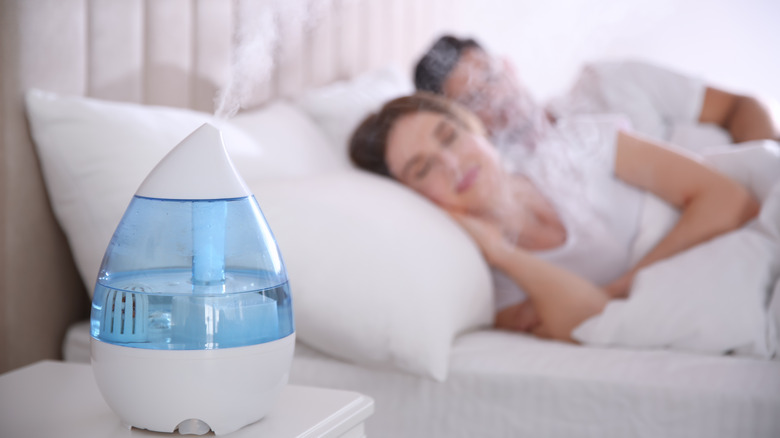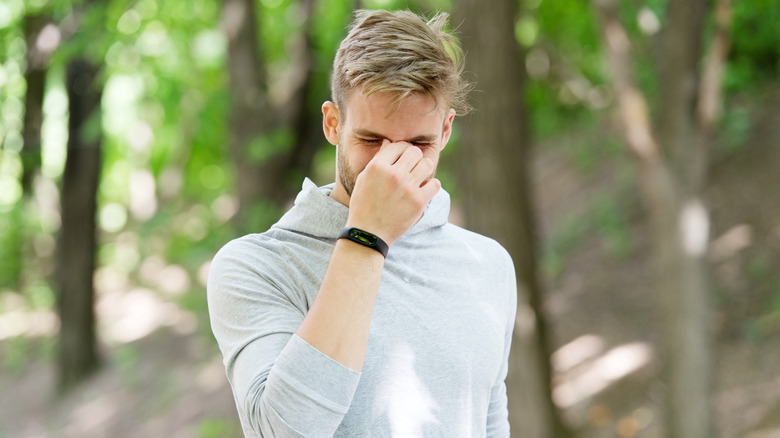Simple Tips For Dealing With Nosebleeds
Imagine you (or your kids) are working on an important project, studying for a test, or coloring your favorite book, when all of a sudden a big dollop of bright red blood falls right in the middle of your paper. How inconvenient — you've got yourself a nosebleed. Nosebleeds (known as epistaxis in medical slang) are a very common and spontaneous medical condition caused by ruptured blood vessels in your nose. They happen to about 60% of people, especially kids between the ages of 2 to 10 and adults between 50 and 80 (via Epistaxis).
There are two types of nosebleeds, anterior and posterior, and the classification depends on whether the ruptured vessels are located at the entrance or the back of your nasal cavity. Anterior nosebleeds are more common because the membrane that covers that area is especially thin and fragile, thus it can get damaged more easily. Plus, the tip of your nose is more exposed to hot and cold temperatures or variations in moisture and humidity levels, and is more easily injured. There are numerous potential causes for nosebleeds, including environmental factors like dry weather or allergies, medical conditions like hypertension, certain medications such as anticoagulants and nasal steroid sprays, and the use of illicit drugs. Yet, in kids, the most common causes are nose picking, blowing the nose really hard, and having a foreign object stuck up the nose (per Cedars Sinai). Nevertheless, almost all nosebleeds are managed the same way regardless of the cause. Keep on reading to learn simple tricks for stopping nosebleeds.
Nosebleed prevention
Nosebleeds are caused for a number of reasons, most of which can be prevented by making a few simple changes here and there. For example, Cedars Sinai recommends sleeping with a humidifier to tackle nosebleeds caused by dry weather during the winter (the site also urges you to clean it regularly to prevent mold growth). Using a saline nasal spray can also help keep your nasal membranes from tearing up due to excessive dryness. Also, if you're a parent of a child with recurrent nosebleeds, Cedars Sinai suggests teaching them how to gently blow their nose as well as reminding them not to pick their nose to avoid injuring their nasal membranes.
Moreover, since nose trauma can also lead to nosebleeds, Healthline encourages wearing protective gear when practicing sports known to have a high risk of a nose injury, such as karate or hockey, as well as wearing your seatbelt to keep you from hitting your nose in case of a car accident. Lastly, since cigarette smoke can irritate your membranes, the site also suggests quitting smoking and avoiding secondhand smoke when possible. Keep in mind that making these changes does not ensure you'll stop getting nosebleeds altogether, but they can probably at least help you reduce their frequency.
Sit in an upright position
Some may attribute it to being an unconscious reaction, while others might just not want to get blood all over their clothes or important documents. Still, the first thing many people do when their nose starts bleeding is tilt their head backward. Yet, as a 2018 study published in the journal Deutsches Ärzteblatt International explains, this is precisely what you should not do to stop a nosebleed.
In fact, the study recommends doing the very opposite and instructs to sit in an upright position and even lean slightly forward to keep the blood from running down your throat — which, as the Mayo Clinic explains, can lead to swallowing blood and cause an upset stomach (and you definitely will want to avoid that while your nose is bleeding). By sitting in this position, you help lower the pressure on your nasal blood vessels, which helps control the bleeding. You may want to grab a napkin or piece of paper, though, to keep the blood from staining everything around you.
Apply pressure
As with most bleeding wounds, which require you to apply direct pressure on it to stop the bleeding (via Harvard Medical School), the best and most important step for controlling an anterior nosebleed is to apply pressure to your nose, according to a 2018 study published in American Family Physician. This should be done once you're sure nothing is blocking the airways, such as a foreign object or blood clot.
According to the study, since an anterior nosebleed is the type caused by broken blood vessels in the tip of your nose, you should firmly pinch both nostrils with your thumb and index fingers at the cartilage or the soft part of the nose right under the bone, and hold the pressure for at least 10 to 15 minutes without interruption (remember to breathe through your mouth while doing so). American Family Physician also recommends repeating this process for 20 more minutes if your nose starts bleeding again after you let go.
Use a nasal spray
Nasal sprays containing Oxymetazoline (such as Afrin) are an excellent tool for stopping nosebleeds. Oxymetazoline is a vasoconstrictor — meaning that it shrinks blood vessels and, therefore, can help reduce or control a bleeding nose (via Enclara Pharmacia). Plus, it is an inexpensive and accessible medication you can find in almost any pharmacy. These types of nasal sprays are also very easy to use and can be used every eight hours for up to three days. Simply insert the bottle's nozzle into your nose and take a deep breath while pumping two squirts of the medicine into each nostril (make sure to gently blow your nose first to ensure your nose is clear before using the spray).
However, note that some common side effects of using Afrin nasal spray include a slight burning or stinging feeling (via Drugs.com). It can also irritate your nose and cause sneezing or runniness, and it can interact with certain drugs, such as certain migraine medications and antidepressants.
Use a silver nitrate stick
According to a 2018 study published in the American Family Physicians, using a silver nitrate stick can be an effective way of stopping a nosebleed in cases when applying pressure is not working. The study explains that silver nitrate creates a minor chemical burn when it touches mucous membranes, like the ones inside your nose. This means that it works as a heatless cauterization agent that helps form a scab that keeps the blood vessels from bleeding.
Nevertheless, the study warns that this is a procedure that should be performed by a doctor to avoid damaging or perforating your nasal tissue. Furthermore, some people may experience allergic reactions to silver nitrate and present symptoms that are very similar to those of a food allergy, such as hives, breathing trouble, and swelling of the face or throat (via Drugs.com). If this happens to you, you should seek medical help right away.
Does the strategy of applying ice work?
Some medical professionals recommend applying a cold compress or a bit of ice at the back or nape of the neck to control a nosebleed, according to a 2018 study published in the journal Deutsches Ärzteblatt International, though there is no medical consensus around this tip. Per the study, this minimally invasive technique is meant to encourage the shrinking of the blood vessels that reach the nose, which would help limit blood flow and stop the bleeding — meaning that it acts as an alternate vasoconstriction method. However, per another study published in the journal Clinical Otolaryngology and Allied Sciences, this might not be the most helpful method. In the study, researchers evaluated the effect of applying ice around the neck area on the blood flow of nasal blood vessels to see if it actually helped shrink them. In the end, they determined that there was no statistically significant change and, thus, deemed the technique unsuccessful.
What not to do to stop a nosebleed
Since nosebleeds are pretty common, you'll most likely hear countless opinions on how to stop them. But there are a few definite no-nos when it comes to managing a bleeding nose. As ear, nose, and throat (ENT) surgeon Mohamad Chaaban told the Cleveland Clinic, the number one thing you want to avoid is tipping your head back — even if this is one of the most popular suggestions. The simple reason behind this recommendation is that by tilting your head, you'd be redirecting the blood toward your stomach, which may increase the risk of choking and potentially cause a stomach ache and vomiting.
Dr. Chaaban also warns against packing your nose with tissues, napkins, toilet paper, or cotton. While nose packing is an alternative treatment method, it should be performed by a medical professional — and yet, rebleeding still happens in about 15% of the cases, according to a 2018 study published in American Family Physicians. Someone doing it at home has a higher likelihood of irritating their mucosa and causing even more bleeding. Lastly, Dr. Chaaban advises being patient when applying pressure to the tip of the nose, as stopping every few minutes to check if the bleeding is gone will only take you back to square one (via the Cleveland Clinic).
What to do after a nosebleed
Let's say you got a nosebleed and finally managed to control it. How do you keep it from happening again? Some useful tips on preventing rebleeding include avoiding picking your nose — yes, as obvious as it sounds, you should keep your hands away from your nose to prevent causing more irritation to the nasal tissue (per Healthline). In addition, you should try to avoid activities that require extra effort or increase the pressure in your head, such as bending down and lifting weights or other heavy objects.
Moreover, it would be best to avoid blowing your nose during the first 24 hours after a nosebleed, and only doing so gently if it is an absolute must. Lastly, Healthline also suggests avoiding consuming hot liquids like soup, coffee, or tea within the first day after a nosebleed. You may also want to consider suspending use of anticoagulants or blood-thinning drugs for a day or two, as long as you consult with your doctor first.
When to see a doctor
You could say nosebleeds are more of an unfortunate inconvenience rather than a serious medical condition. In fact, per the Epistaxis, they hardly ever turn into a fatal event, accounting for just four in over two million deaths in America. Still, there are some specific cases that may require a visit to your healthcare provider, or more specifically, an ear, nose, and throat (ENT) doctor, such as if you have them more than twice per week or if it takes you over half an hour to stop the bleeding (per Healthline).
Frequent and long-lasting nosebleeds may require cauterization of the blood vessels in your nose — meaning that your doctor carefully burns them to keep them from bleeding (via the Mayo Clinic). Furthermore, people taking anticoagulant drugs (blood thinners) might also have more trouble stopping a nosebleed. Dr. Troy Madsen from emergency medicine at the University of Utah Hospital told The Scope, University of Utah Health Sciences Radio that a nosebleed for someone on these medications can become a significant problem and may require a visit to the emergency room (ER) so that medical professionals can properly pack it and keep an eye on your nose.









